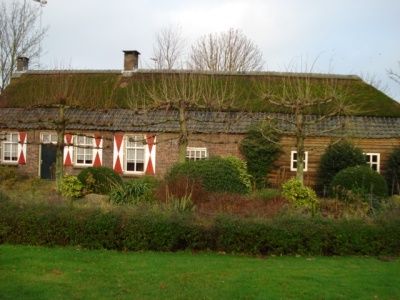Boerderij: Oude langgevel, Bakel
Bakel. Old long-gabled farmhouse, a common farm form in North Brabant.
Prehistoric farms looked like upside-down boats, long, narrow and with a high thatched roof, all to keep it as sturdy as possible. …
Bakel. Old long-gabled farmhouse, a common farm form in North Brabant.
Prehistoric farms looked like upside-down boats, long, narrow and with a high thatched roof, all to keep it as sturdy as possible. Back then and until the 20th century, farms had no walls supporting the roof but an internal structure of wooden beams on which the thatched roof rested and small walls of loam or wood were built against. This farm also still has a truss construction despite its relatively late construction. Historically, the oldest farm form in Brabant is the hallehuis, an oblong building with stable and living quarters under one roof. Originally there was no partition between people and livestock, but this was introduced later. Together under one roof, livestock provided extra warmth and people could keep an eye on them. In the late Middle Ages, the potting shed began to emerge. A potting shed turned the stable into an open space in which the cattle roamed freely, and so was mucked out once every six months. This manure, mixed with the stable litter on the floor, mainly peat in the Peel, was spread on the fields to improve the harvest. Given the poor soil, this was much needed and the potting shed system therefore functioned for many centuries in Gemert-Bakel, as can also be seen by the convex fields that visibly bulge due to centuries of manure and peat application. Needless to say, this method of housing encouraged diseases of cattle and people. In any case, it is now believed that the large and important role that cattle played in European society for millennia led to most of the infectious diseases now known as chicken pox.
In the Golden Age, many changes took place in agriculture, mixed farming began to specialise, farms intensified, and farm types became more diverse. In the Peel, because of its remote and inhospitable location, these changes occurred much more slowly, which is why many recognisable halle houses can still be seen in the municipality of Gemert-Bakel, although these evolved along with changing farm management later often adapted into the long-gabled farmhouse. The long-gabled farmhouse had load-bearing walls and was widely built in the first half of the 20th century. The wolf end, that notch in the roof, visible on the left side of the farmhouse in the photo is also a typical Brabant feature. It was particularly common in the Peel region. After all, brick used to be expensive and was bought in batches here and there. If the whole top gable had to be bricked, it was more expensive than if the cheap thatch and straw could be laid down from the roof. There were originally two wolf ends here, and later one was removed and replaced with brick. People started using brick first in the main house, and this farmhouse shows that part of the barn section is made of wood. Earlier, such a barn section would have mud walls. Roof tiles were also expensive and if bought were laid from bottom to top, sometimes replacing the thatched roof entirely with tiles and sometimes not, as in this case. This farm is not large, and typical of its location on poor land on the edge of where the Peel marshes once began. Even further down the Zand street, small crofts are still visible. For an overview of how daily life was on such a farm around 1900, the Farmers' Union Museum in Gemert is the place to be.
Sources:
R. van den Broek, J. Timmers, W. van de VossenbergBoerderijen kijken in Gemert-Bakel: Drie fietsroutes langs boerderijen in de gemeente Gemert-Bakel, 2003, Heemkundekring De Kommanderij, Gemert
S. Hendrikx, Brabantse Boederijen: Beleven, bewonen en bewaren, 1994, Kemen Publishers, Eindhoven
Municipality of Gemert-Bakel, Monument description

